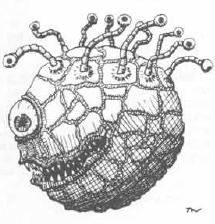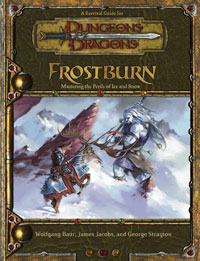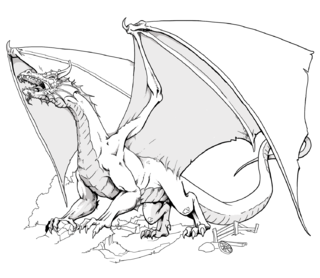3rd and 3.5 editions
Aberration
An aberration can have a bizarre anatomy, strange abilities, alien mindset, or any combination thereof. Examples include the beholder, illithid (mind flayer) and rust monster. The rules state that all aberrations have darkvision out to 60 feet. As a group, they have no other special abilities or immunities. [1]

The beholder is a fictional monster in the Dungeons & Dragons fantasy role-playing game. Its appearance is that of a floating orb of flesh with a large mouth, single central eye, and many smaller eyestalks on top with powerful magical abilities.

In the Dungeons & Dragons fantasy role-playing game, illithids are monstrous humanoid aberrations with psionic powers. In a typical Dungeons & Dragons campaign setting, they live in the moist caverns and cities of the enormous Underdark. Illithids believe themselves to be the dominant species of the multiverse and use other intelligent creatures as thralls, slaves, and chattel. Illithids are well known for making thralls out of other intelligent creatures, as well as feasting on their brains.

A rust monster is a fictional creature from the Dungeons & Dragons fantasy role-playing game that seeks out and consumes metal, often the armor and weaponry of players' characters. Originally inspired by a cheap plastic toy, the rust monster was one of the first monsters specifically created for D&D, and has been included in every edition of D&D, although various aspects of the creature have changed from edition to edition. Although in most editions, the rust monster has been a non-lethal creature with little or no way of physically harming players' characters, it is the rust monster's ability to destroy a character's cherished and expensive weapons and armor in mere seconds that makes it a particularly fearsome opponent.
Animal
The game classifies "Animals" as living, nonhuman vertebrate creatures, with no innate magical abilities or capacity for language or culture. Virtually all animal type monsters are based on real world animals. Creature entries based on mythological, fictional, or nonexistent animals are usually classified as magical beasts (see below). Besides ordinary fish, birds, reptiles and mammals, the animal type is also applied to depictions of dinosaurs, prehistoric animals, and "dire" (or specially modified, re: larger and scarier) versions of real world animals (see below).
Some real world animals are not given the animal type in the game. Examples include arthropods (insects, spiders, etc.) and worms, which the game classifies as "vermin" (see below) and not animals. Mollusks, such as octopuses, are often classified as animals. Creatures deemed inconsequential by DMs or designers are not given any creature type at all, instead being treated as "set dressing" unless a specific game effect targets such non-creatures. Examples include actual-sized spiders, sparrows, fleas, worms, shellfish, and mice. "Swarm" type creatures are occasionally written to represent such otherwise nonthreatening creatures if they were to group together by some force of magic within the game world.
Under the rules of D&D, animal type creatures do not have an Intelligence score higher than 2. When a designer makes a change to an animal creature that increases its Intelligence or grants it additional abilities, the designer is encouraged to also change the creature's type, usually from animal to magical beast. When real world animals are rendered as vermin (see below) in D&D, they have no Intelligence scores at all.
Dire animals
Dire animals are larger, tougher, meaner versions of regular animals. They closely resemble their normal counterparts, only are larger and more powerful, and with a feral, prehistoric, and even demonic countenance. Sharp, ugly, bony ridges protrude from their spines, limbs and head. Dire animals cannot speak, are of animal intelligence and carry no equipment.
- History
The third edition Monster Manual introduces twelve dire animals: dire ape , dire badger , dire bat , dire bear , dire boar , dire lion , dire rat , dire shark , dire tiger , dire weasel , dire wolf , and dire wolverine . [2] The same dire animals are presented again in the version 3.5 Monster Manual. [3] [4] [5] Each of these twelve creatures is described in its own section below. Masters of the Wild introduces six new dire animals. [6] The animals are: dire elephant , dire elk , dire horse , dire hawk , dire snake , and dire toad . [6] The Monster Manual II features six updated dire animals, [7] updated versions of the monsters published in Masters of the Wild. [6] The third edition Fiend Folio introduced one new dire animal, the dire rhino . [8]

The Monster Manual (MM) is the primary bestiary sourcebook for monsters in the Dungeons & Dragons (D&D) fantasy role-playing game, first published in 1977 by TSR. It includes monsters derived from mythology and folklore, as well as creatures created specifically for D&D. It describes each with game-specific statistics, and a brief description of its habits and habitats. Most of the entries also have an image of the creature. Along with the Player's Handbook and Dungeon Master's Guide, it is one of the three "core rulebooks" in most editions of the D&D game. Several editions of the Monster Manual have been released for each edition of D&D. It was the first hardcover book of the D&D series. Due to the level of detail and illustration included, it was cited as a pivotal example of a new style of wargame books. Future editions would draw on various sources and act as a compendium of published monsters.

Apes (Hominoidea) are a branch of Old World tailless simians native to Africa and Southeast Asia. They are the sister group of the Old World monkeys, together forming the catarrhine clade. They are distinguished from other primates by a wider degree of freedom of motion at the shoulder joint as evolved by the influence of brachiation. In traditional and non-scientific use, the term "ape" excludes humans, and is thus not equivalent to the scientific taxon Hominoidea. There are two extant branches of the superfamily Hominoidea: the gibbons, or lesser apes; and the hominids, or great apes.

Badgers are short-legged omnivores in the families Mustelidae, and Mephitidae. They are not a natural taxonomic grouping, but are united by possession of a squat body adapted for fossorial activity. All belong to the caniform suborder of carnivoran mammals. The 11 species of mustelid badgers are grouped in four subfamilies: Melinae, Helictidinae, Mellivorinae, and Taxideinae ; the respective genera are Arctonyx, Meles, Melogale, Mellivora and Taxidea. Badgers include the most basal mustelids; the American badger is the most basal of all, followed successively by the ratel and Melinae; the estimated split dates are about 17.8, 15.5 and 14.8 million years ago, respectively. The two species of Asiatic stink badgers of the genus Mydaus were formerly included within Melinae, but more recent genetic evidence indicates these are actually members of the skunk family.
Races of Stone introduced the dire eagle . [9] Frostburn introduces numerous dire animals more suited to cold environments. Many of them are not named 'dire [animal name]' but are still counted as dire animals. They are the: dire polar bear , megaloceros , glyptodon , sabretoothed tiger , wooly mammoth [ sic ] [10] and zeuglodon . [11] Libris Mortis does not technically introduce any dire animals, however, the dire maggot is named 'dire', despite the fact that it is of the vermin type; [12] it is more usual to describe giant versions of real life vermin as monstrous, not dire, which is generally reserved for animals. [3]

Races of Stone is an optional sourcebook for the 3.5 edition of the Dungeons & Dragons fantasy role-playing game.

Eagle is the common name for many large birds of prey of the family Accipitridae. Eagles belong to several groups of genera, not all of which are closely related. Most of the 60 species of eagle are from Eurasia and Africa. Outside this area, just 14 species can be found—2 in North America, 9 in Central and South America, and 3 in Australia.

Frostburn is a supplemental book to the 3.5 edition of the Dungeons and Dragons fantasy role-playing game.
Races of the Wild featured the dire hawk'. [13] Sandstorm introduced several new dire animals suited to a warmer environment. These were: dire hippopotamus , dire jackal , dire puma , dire tortoise , and dire vulture . [14] Stormwrack introduced two new dire animals, both designed to be well suited to an aquatic environment. They were the dire barracuda and the dire eel . [15] The book Dragon Magic introduces the dire phynxkin. [16] [17]
Beast
In 3rd edition, the beast type was used for nonhistoric and fantastic, but not necessarily magical vertebrates. The beast type was merged into the animal type in 3.5 edition.
Construct
A construct is either an animated object of some sort, or an artificially crafted creature. Most construct are mindless automatons, obeying their creator's commands absolutely. This makes them immune to bribery and absolutely trustworthy, although some take their orders literally and fail to consider their intent. A few constructs, however, such as Inevitables, are as intelligent as living creatures. As they lack a metabolism or internal organs, constructs are immune to many effects, such as poison, fatigue, exhaustion, disease, ability drain, level drain, death effects and critical hits.
Constructs are almost always created by wizards, sorcerers or clerics, though some are created by other character classes or spell-casting monsters. The first step in making a construct, sometimes performed by a non-spellcaster, is building the body; the second is a ritual requiring the casting of specific spells to bind a spirit of some kind (typically an elemental drawn from the Inner Planes) into the body and imbue it motion and special abilities. Most constructs are made of metal, but other materials — including bone and corpses—can be used.
The creation methods for certain constructs are unknown, or might have much more stringent requirements. Warforged, for example, can only be created with the help of specific artifacts, the creation forges. Golems are the best-known type of construct.
Dragon
A dragon is a reptile-like creature, usually winged, and tends to have magical or unusual abilities.
Elemental
An elemental is composed of one or more of the four classical elementals of air, earth, fire, or water. Elementals almost always have the extraplanar subtype. Most natives of the elemental planes are elementals, however there are some exceptions, for example most types of genies are native to the elemental planes, however genies are outsiders.
Fey
A fey is a creature which usually has supernatural abilities and a human-shaped form. A fey also usually connected to nature, or some other force or place. Many are based on faeries from mythology. Fey share a common native language called Sylvan.
Giant
A giant is a humanoid-shaped creature of great strength and size. All giants have low-light vision. As a group, they have no other special abilities or immunities.
Humanoid
Humanoids are bipeds of Small or Medium size with few or no supernatural or extraordinary abilities. Most humanoids can speak, and usually have well-developed societies. Larger bipeds are giants (see above), and bipeds with more special abilities are fey, monstrous humanoids or outsiders. In 3.0 and 3.5 editions, the Player's Handbook races (humans, dwarves, elves, gnomes, halflings, half-elves, half-orcs) are all humanoids.
Prior to 3rd edition, "humanoid" referred exclusively to orcs, goblinoids and similar creatures, while more advanced creatures such as Elves and Dwarves were referred to as demihumans and humans were outside of both categories.
Magical beast
A magical beast is similar to an animal in many ways, but usually has a higher intelligence, and possesses supernatural or extraordinary abilities. Examples include manticores and pegasi. All magical beasts have darkvision out to 60 feet as well as low-light vision; as a group, they have no other special abilities or immunities.
Monstrous humanoid
A monstrous humanoid is similar to a humanoid (see above), but usually has monstrous or animalistic features. Examples include harpies and minotaurs. All monstrous humanoids have darkvision out to 60 feet; many have supernatural abilities as well.
Ooze
An ooze is an amorphous or mutable creature without a single solid form. Oozes are usually mindless and homogeneous, and reproduce by simply splitting into two. The most famous ooze is the gelatinous cube. Many oozes dwell underground, and most secrete an acid from their skin that dissolves flesh and other materials rapidly. Oozes are essentially blind, but an ability called "blindsight", which allows them to discern nearby objects and creatures without needing to see them, more than compensates for this.
Outsider
An outsider is at least partially composed of the essence (if not the material) of a plane other than the Material Plane. Most outsiders (including angels, demons, devils and most genies) have the extraplanar subtype and are native to another Plane, such one of the Outer Planes or Elemental Planes; the rest (such as aasimars, tieflings and couatls) have the native subtype and are native to the Prime Material Plane. All outsiders have darkvision out to 60 feet. As a group, they have no other special abilities or immunities.
Planetouched
Planetouched are mortal creatures whose ancestors were extraplanar creatures such as celestials, fiends, or elementals. Aasimar (humans with celestial blood), tieflings (humans with fiendish blood) and genasi (humans with elemental blood) are the primary planetouched races. Other examples include tanarukk (orcs descended from demons) and celadrin (elves descended from celestials).
Plant
A plant is a vegetable creature that can perceive and affect the world in some way. Ordinary plants are considered objects rather than creatures.
Shapechanger
Shapechanger was a type in 3rd edition. It was converted to a subtype in 3.5 edition.
Undead
An undead is a once-living creature animated by spiritual or supernatural forces. Some, such as ghosts and vampires, have Intelligence scores; others, such as zombies, do not. All undead have darkvision out to 60 feet and immunity to mind-affecting effects, poison, sleep effects, paralysis, stunning, disease, death effects, critical hits, nonlethal damage, ability drain, or energy drain. In general, cleric spells that heal other creatures damage undead, and vice versa. Most undead can be "turned" (destroyed or driven away) by a Paladin or good Cleric or "rebuked" (controlled or made to cower in awe) by an evil Cleric.
Vermin
A vermin can be an insect, arachnid, arthropod, worm, or other invertebrate. Some have magical abilities, and others are giant versions of real insects. Most vermin are considered mindless individually. Since many vermin are too small to model individually, they are often represented as swarms (clusters that act like single creatures and sometimes have hive minds).














